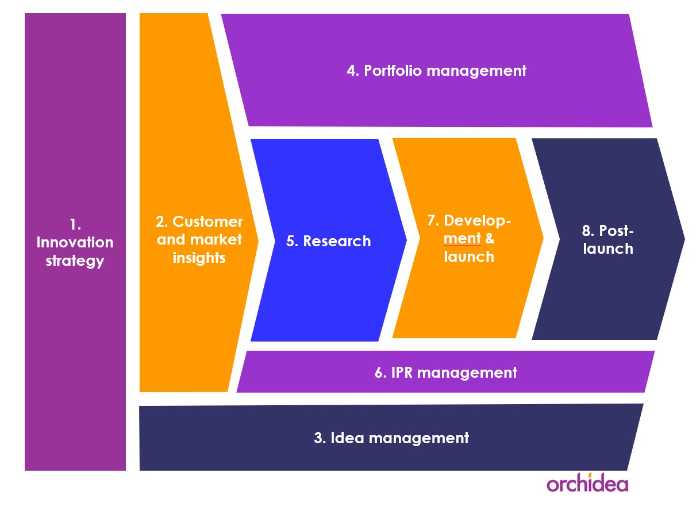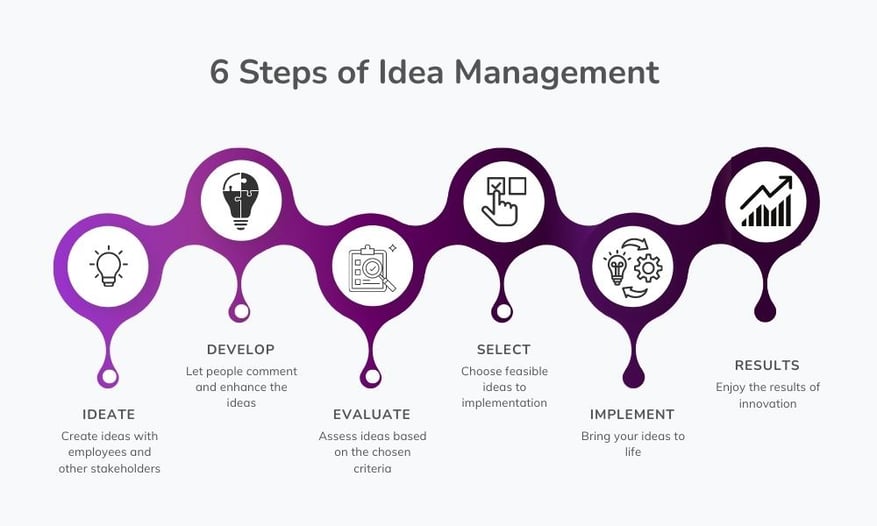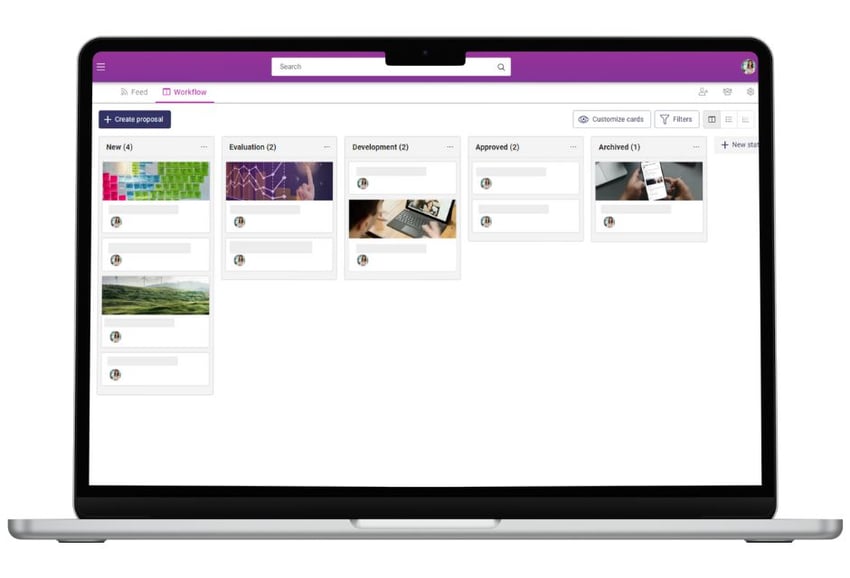Organizations are aware that innovations can help in growth and staying relevant. It is at the core of success. Innovation starts with generating ideas. Many companies encourage their employees to be innovative and develop new ideas. However, these ideas remain thoughts without systematic and well-considered processes and never become reality. This is where systematic idea management comes into play.
In this post, we'll cover the following topics:
- What is idea management: a quick definition
- Idea management vs. innovation management?
- Why is idea management system needed?
- What to keep in mind in idea management?
- A typical idea management process
- Examples of different types of idea management
- Idea evaluation models
- The advantages of dedicated idea management software
- Tips for idea management
What is idea management: a quick definition
Idea management focuses primarily on creating, developing, and implementing ideas. The aim is to create value from these ideas and turn them into reality.
Gartner defines idea management as follows:
"Idea management is a structured process of generating, capturing, discussing and improving, organizing, evaluating and prioritizing valuable insight or alternative thinking that would otherwise not have emerged through normal processes."
According to a study (Brem & Voigt, 2007), idea management aims to generate, evaluate, and select ideas efficiently. There are a couple of things that make idea management difficult. Firstly, how to systematically collect and develop ideas. And secondly, the logical and fair evaluation and selection of those with the most significant potential for the company's future success.
Idea management vs. innovation management?
Term idea management is sometimes confused with innovation management. Actually, they are two different but linked concepts.
So, here’s the difference: Innovation management is the process through which an organization manages and implements innovation. It contains the process of managing all aspects of the innovation process. It is about organizational structures and methods that help an organization foster innovation and bring new ideas to life.
Idea management, on the other hand, is a sub-process of innovation management. It is a system that helps to generate, develop, and implement ideas. Organizations usually use idea management systems to supplement their innovation management processes. Idea management takes place at the forefront of innovation management.
Where idea management stands in the innovation process is shown in the picture below.

In our experience, most organizations start focusing on systematic idea management when they have systematic project management and want to implement the same systematic approach to ideation. Another typical driver is the need to improve business and innovation strategy linkage. According to Stratregy& research, companies with more tightly aligned business and innovation strategies had 40 percent higher operating income growth over a three-year period and 100 percent higher total shareholder returns than industry peers with lower strategy alignment.

Why is idea management system needed?
To increase innovation success, organizations must build a system. The system regulates the way it collects information and actions. Companies tend to have plenty of innovation potential in their employees, and organizations could benefit significantly from engaging the whole organization to share ideas. You need idea management to organize that. It helps to manage ideation systematically and provides the basis for innovation.
"Every employee has the capacity for innovative ideas but it depends on idea management to use this capacity" (Saatciouglu, 2002)
Idea management is important because it:
- Encourages employees’ creativity to generate new ideas
- Collects all the ideas in one place
- Helps to evaluate and prioritize ideas
- Helps to implement the best ideas
- Makes the innovation process more efficient
- Increases chances of successful innovation
Idea management is a vital part of innovation management. It’s an essential pillar of systematic business management in general. By using an idea management system, organizations can use their full innovation potential and increase their chances for growth.
|
Case example: From a single R&D unit to global collaborationA global company started to investigate where their innovations stem from. They found out the source of their innovations was a small group of individuals, most situated in a single location. They wanted to engage the whole organization globally to innovate and formed three vital management groups to organize innovation:
1. Steering group for the process: A dedicated person responsible for the operations regarding innovation, and idea management system Orchidea.
2. Steering group for innovation proposals: Create the pull for attractive ideas and provide a forum to present the ideas.
3. Management group: Unit directors decide on the annual goals and rewardings.
They also established two key roles that have distinct responsibilities but collaborate to ensure smooth idea management.
1. Business owner: The person who needs new ideas. Is the godfather of innovation and makes initial decisions based on the bigger picture.
2. Champion: Facilitator of idea management and does the hands-on work regarding innovation. The champion works closely with the business owner, taking the lead on initiatives and driving them forward.
These two roles collaborate in a specific business area to assess and make decisions on ideas. They also monitor the results with KPIs such as lead time, user activity, number of new ideas, and number of approved ideas. We recommend such metrics for starting systematic idea management.
|
What to keep in mind in idea management?
When defining the approach to idea management, the first question to answer is why the organization wants to manage ideas. Typical reasons are:
- Develop new products or services
- Improve existing products or services
- Find new ways of doing things
- Save costs
- Create new revenue streams
Once the purpose is clear, defining how you should manage ideas will be easier. After that, you should determine who is responsible for different tasks in idea management and the role of various stakeholders in the process. It would be best to name a manager for an idea, topic, or campaign. The manager is responsible for sending out requests for evaluation and ensuring that ideas move forward in the process.
There are a few key things to remember when doing idea management:
- Define the scope and objectives of the ideation process
- Choose the right evaluation model
- Ensure transparency and a fair evaluation process
- Assure that all relevant stakeholders are committed to their roles in the process
- Communicate the results of the ideation process to all relevant stakeholders.
Idea management is an integral part of the innovation process, and it’s crucial to get it right to ensure successful outcomes of the innovation process. Following the best practices can set your company up for success.
A typical idea management process
There are different idea management strategies, each with unique characteristics and methods. They mostly still share the same basic process:
1. Idea generation and collection: This is the first stage of idea management, and it involves collecting ideas from employees, customers, and stakeholders. At this stage, ideas are generated. You can generate ideas through brainstorming, problem-solving with innovation challenges, or other creative methods. The important thing is to encourage employees to come up with ideas.
2. Developing ideas: At this stage, you refine ideas into feasible solutions. Make sure you activate the ideators to develop others’ ideas to get the best solutions.
3. Evaluating ideas: In this stage, you screen the ideas to find the ones worth pursuing. There should be transparent evaluation criteria, a process defined in advance, and the people responsible. There are different evaluation models we’ll describe later on.
4. Selecting ideas: In this stage, select the best ideas for further development and implementation. Approved ideas go straight to the next stage, i.e., implementation or, for example, customer mapping, followed by implementation. Make sure you have a plan and the resources needed for implementation. Other ideas are stored in an archive, waiting for future needs or merging with different concepts.
5. Implementing ideas: This is the stage where ideas are implemented and brought to life. Make sure you communicate about the implementation to increase motivation to participate.
6. Results: At this stage, you monitor the process, collect feedback, and communicate the wins. In this stage, you can also enjoy the benefits of innovation.

There are different ways to go about idea management, and the best way depends on the organization’s needs and resources. Many software tools are available to help with idea management, but it is also possible without any specific technology. The important thing is to have a straightforward process in place so that you generate, collect, and evaluate ideas in a structured way.
7 common mistakes in building an idea management process
- Making the process too complex. We have observed that some organizations are tempted to create complex processes. We suggest you start with a simple process and implement it. After a few months, you can identify any missing elements that can easily be incorporated.
- Forgetting why the innovation process is called a funnel. Not all ideas will make it through to implementation. The process is designed to filter out less feasible ideas, allowing the most promising ones to progress.
- Collecting unnecessary, nice-to-have data. Minimize the data required from the idea submitter, as this increases the number of ideas. In the realm of innovation, a higher quantity ultimately leads to better quality.
- Idea submitters never get feedback; the most common phrase used in the context of unsuccessful idea management is “black hole”, ideas disappear and creators never hear of them.
- Regular communication is not built into the process. Communication about successes increases motivation to continue participating.
- Strategy and targets are not linked to evaluation. Include evaluation criteria that assess ideas against strategic targets. Ideas aligned with a strategy and targets have a higher likelihood of being put into action, which in turn increases the satisfaction and commitment of top management to the idea management process.
- All ideas are decided by the leaders: Leaders should not be burdened with making decisions for every small idea as it becomes cumbersome. Smaller ideas can be implemented and processed without leader assessment.
Examples of different types of idea management
Continuous ideation
Continuous, open ideation, for example, for a suggestion box, can be conducted in two ways: having regular, e.g., monthly processing or based on when the idea is submitted.
In the first case, there is usually a time, for example, one week each month, when you review the ideas submitted during the month. In the latter case, you evaluate the idea during an agreed period, for example, two weeks after submission.
|
Case example: Weekly feedback drives participation in power plantTo foster collaboration and co-development, the power plant implemented a fresh approach to continuous innovation. The results were remarkable. The number of new ideas increased from 20 to 100 within a year. This success was due to multiple factors.
The company closely tracked the realized savings through post-analysis calculations, resulting in an impressive annual savings of over 1 million.
|
Product and service development
Product and service development focuses on improving existing products and services or developing new ones. In this instance, often, there are several great ideas, but the implementation is more expensive. Investments in product development are often higher, with a correspondingly higher return on investment expectation. While there are plenty of ideas for implementation, companies must be strategic about their choices, given the budget and resource constraints.
The evaluation is often more thorough and numerical. There are different criteria depending on the idea type. Usually, in product development, evaluation models like RICE or traditional numerical evaluation are used. The review may also consider the feasibility of implementation and the market potential.
Idea campaigns
Idea campaigns, such as innovation challenges, efficiently generate ideas on a specific topic and crowdsource the ideas from relevant stakeholders. The idea management in these is linked with the schedule of the challenge. In an innovation challenge, there are phases for idea collection, development, evaluation, and top idea selection. The idea management happens in line with the challenge schedule.
Since there is only limited time to create and develop ideas in the challenge, it is vital to communicate regularly and activate the participants. A panel of experts typically evaluates the ideas. The criteria used to assess the ideas differ for each challenge but usually include originality, feasibility, and alignment with the topic.

Idea evaluation models
There are multiple ways to evaluate ideas. Different ideation processes, objectives, and goals require their specific criteria and evaluation models to review ideas. We recommend you choose and communicate the idea evaluation model beforehand to make idea management seamless and fair. Here are a few to mention:
Expert opinions
In this model, experts review the ideas. It is favored when the organization wants new perspectives or if complex concepts need in-depth understanding. The evaluation is based on the experts' opinions, and the ideas are not evaluated numerically. The assessment can be a simple textual feedback to a question like “Would you implement this idea?” or a broader statement on the idea's feasibility.
Numerical evaluation
This is a more structured way of evaluating ideas, using quantitative criteria to review the submissions. The evaluation happens against 3-4 criteria. For example, you could evaluate a new product idea on its potential market size, feasibility, and alignment with the company strategy. This type of evaluation is the most suitable when there are many ideas to review, and the company wants to focus on the few with the most potential. In this case, each export gives a value to the concept (1-5) on each of the chosen criteria. The criteria can, for example, be feasibility, impact, or novelty.

Weighed assessment
The weighted assessment is similar to the numerical evaluation, but each criterion is weighted according to its importance. So, if the company strategy is deemed more important than potential market size, it impacts the final score more significantly.
RICE -model
The RICE model is commonly used in product development to assess and prioritize initiatives. It stands for Reach, Impact, Confidence, and Effort. It is ideal when you have many ideas and you want to focus on a few high-impact ideas. In this case, each reviewer gives a value to the idea (1-5) on each of the four criteria.

It’s vital to remember that no matter which evaluation model you choose, you should ensure that the evaluation is as fair as possible. That means that all stakeholders should have a chance to know the criteria and that the process should be transparent.
Multi-step evaluation
Multi-step evaluation is great for evaluating a vast amount of ideas efficiently. The first round is a quick "Yes -Maybe -No" evaluation that quickly reduces the mass of proposals. A more detailed numerical evaluation with multiple evaluation criteria is carried out only for the chosen ideas of the last round, allowing evaluators to focus their time on only the most relevant ones.
The advantages of dedicated idea management software
Using idea management software has several benefits, especially if running an extensive ideation process. First and foremost, idea management tools make collecting ideas from all relevant stakeholders easy. It provides a dedicated space for creativity. That way, you can be sure that all ideas are gathered in one place and are not lost in the process.
Secondly, idea management software helps you track all the ideas. Having everything in one place makes reviewing and comparing them easy. It saves time and resources, as you don’t have to go through different channels sorting and filtering ideas. For example, you can easily see which ideas have been evaluated by experts or which ones are most popular among employees.
Another benefit of idea management software is that it can help improve communication and collaboration within the organization. This is because ideation is a process that requires different stakeholders to work together.
Using idea management tools can also help you to save time and resources. It allows you to automate tasks like sending reminders or assigning project managers for ideas. Some idea management software also comes with AI features. AI-powered idea management can help save time and effort through AI-assisted evaluation, idea grouping, or idea generation.
Idea management software also allows you to monitor the performance of your ideation process. The purpose of reporting and analytics is to help you measure the success of your process and improve it for the future.
Finally, many idea management platforms offer features that help you with evaluation. For example, some platforms have built-in automation for evaluation, features of numerical assessment, and the possibility to assign tasks.
An organization can proceed with a few good ideas with no specific software solution. However, if you have tens of ideas, idea management software saves time and provides you with reporting on your process. You can quickly start using the free version of Orchidea today and make your idea management easier.
Tips for idea management
Here are some tips for effective idea management:
- Encourage everyone to participate: Make sure everyone in the organization knows they can and should contribute ideas. Encourage employees to come up with new ideas and make it easy to submit them.
- Make it a part of the culture: Innovation should be a part of the organization's culture. Ideation should be seen as something positive and essential to the work.
- Define the process: Make sure there is a straightforward process for idea management so that everyone knows what to do and how ideas are processed.
- Evaluate ideas objectively: Ideas should be evaluated objectively based on published predefined criteria. Ensure the evaluation is fair and the best ideas are brought forward.
- Communicate regularly: Communication is critical in idea management. Ensure that everyone knows what is happening with the process and that participants are updated on the progress of their ideas. Also, regular communication keeps ideation in people’s minds.
- Get feedback: Ask for feedback on the idea management process to continuously improve it.
- Celebrate success: When you implement an idea, celebrate the success. It will encourage participation and contribution of new ideas.
Conclusion
Idea management is a process that can help organizations generate, develop, and implement new ideas. It’s a structured process that includes all the steps, from generating ideas to implementing them.
There are different models for idea management, and the suitable model depends on the organization and its needs. However, ensuring that the process is fair and objective and that the best ideas are chosen for further development is essential.
Idea management software can be a great help for companies in managing their ideas. There are a variety of solutions available, and they offer different features. However, most of them provide functionality for improving the efficiency of the process.
Tips for successful idea management include encouraging everyone to participate, making it a part of the culture, defining the process, evaluating ideas objectively, communicating regularly, and getting feedback. It’s also important to celebrate success when you implement ideas.
What are your thoughts on idea management? Share your best tips in the comments!
Orchidea is a versatile innovation tool with solutions for all your innovation activities from brainstorming with a small team to crowdsourcing. Collect ideas from all internal and external stakeholders through permanent channels or with campaigns like innovation challenges and digital workshops.
Sources:
- Brem, A.& Voigt, K-I. (2007). Innovation management in emerging technology ventures – the concept of an integrated idea management. Int. J. Technology, Policy and Management, Vol. 7, No. 3, .304–321
- Gerlach, S. & Brem, A. (2017). Idea management revisited: A review of the literature and guide for implementation. International Journal of Innovation Studies. 1. 144–161.
- Saatciouglu, A. (2002). Using grounded inquiry to explore idea management for innovativeness. Academy of Management Proceedings. 2002. C1-C6.
.jpg)







.jpg)